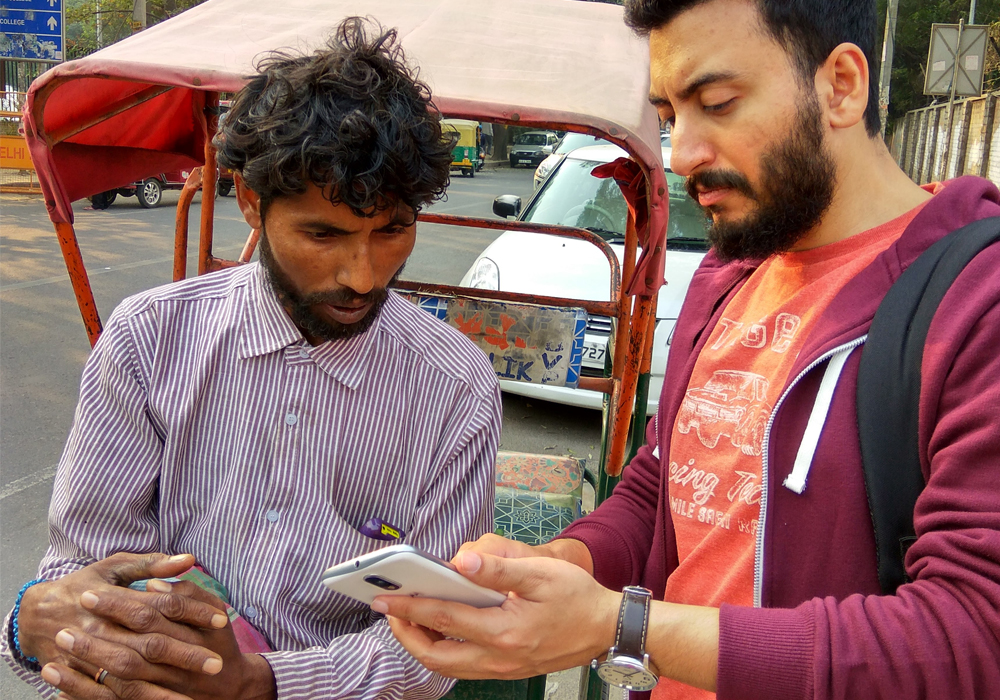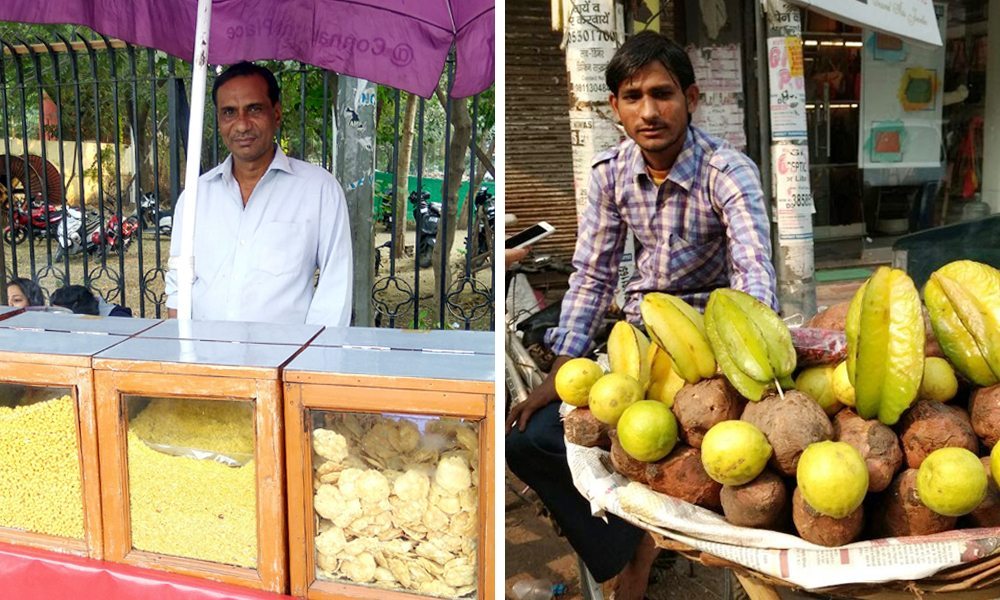“Seekh loonga agar zaroorat padegi toh. Bachche sikha denge (I will learn if I have to. My kids will teach me),” says Mohan Lal, a chaat-papdi seller outside Delhi School of Economics in Delhi University’s North Campus. He was responding to my query on whether he would be willing to go cashless and transact through digital wallets. His lip-smacking fare is popular across North Campus, but business has been scant these past few days. All his transactions are via cash, but obviously.
To check the ground reality about whether the ‘real’ India is ready to go cashless, I was going about North Delhi on Tuesday, trying to teach whoever was willing to learn about mobile wallets and digital payments, when I met Lal. I soon realised that this would involve a steep learning curve for people who’ve never been around a smartphone or used the internet. Even if they’re willing to learn, most of them don’t have smartphones and the money to spare on data plans.
Lal is ready to consider the online route if things on the cash front don’t improve going forward. But that’s because his kids can help him get there. “Mere bachchon ke paas smartphones hain. Woh internet use karte hain (My children have smartphones. They use the internet),” he says, while admitting he has never gone online and has only used a basic feature phone till date. Lal never made it to college but made sure his kids did — his daughter is pursuing her masters in political science, while his son, the younger of the two siblings, is doing his graduation in the same subject.
To check the ground reality about whether the ‘real’ India is ready to go cashless, I went about North Delhi, trying to teach whoever was willing to learn about mobile wallets and digital payments. I soon realised it was a steep learning curve for them
Despite having the assurance that he could take to online payments if the need arises, Lal hopes things will normalise soon and there will be cash in the market. “Sab ke liye toh sambhav nahi hai na sab kuch online karna (It’s not possible for everyone to do thing online),” he says, very rightly so.
Ready to go cashless? Yes, and no
I met one Ranjit Kamti on Bungalow Road in North Delhi. Kamti, who hails from Samastipur in Bihar, has been ferrying people in his cycle-rickshaw for 25 years. He has heard of the internet, but has never used it. I tried explaining online banking and e-wallets to him and he was gobsmacked. “Kuch din koshish karenge toh shayad seekh jayenge (If I try it for a few days, perhaps I can pick it up),” he says. But, the irony is he doesn’t have a smartphone — he can’t afford one. He uses a basic Nokia feature phone.
The Rs 600 he used to earn daily has been reduced to around Rs 300 now for lack of change. “Hum kahan se karenge khulla? Aajkal kuch log do hazaar ka note thamatein hain (Where will I get change from? These days people hand out the new Rs 2,000 note),” complains Kamti. He got his savings exchanged into smaller notes through middlemen, who are reportedly taking a commission of Rs 100-200 for exchanging every old Rs 500 note. “Uss khulle se khaoon ya customer ko doon (Should I keep that change to buy food or give it to customers?),” he rues.

Next I tried my luck with Mukesh Kumar, a ‘churanwallah’ (someone who sells digestives and mouth freshener) in Delhi’s Kamla Nagar Market. When I show him how online transactions happen, Kumar, who went to school in Uttar Pradesh’s Etah district till the ninth grade, says, “Aasaan lagta hai, kar lunga main (Seems easy, I think I will be able to do it).” But, while he has a basic Micromax smartphone that’s internet enabled, he doesn’t have the money to get an “internet recharge” on his phone.
Once sales normalise a bit and money starts flowing in again, he would perhaps consider transacting online for his business, he says. His business too has been hit and is down by 50%. He used to make around Rs 2,000 a day earlier.
“Na ho payega, bhaisahab”
However, for every “aam aadmi” who feels he / she will be able to learn new ways of transacting, there are hundreds others who don’t think they have the smarts to go digital. Take the instance of Hari Singh, who sells sugarcane juice by the roadside. “Nahi ho payega humse yeh, sahab,” he says, referring to e-wallet transactions. Singh’s done schooling till the eighth grade in UP’s Bareilly, but is averse to technology. He has a feature phone which he leaves at home.
Similarly, Vijay Pal, who sells sweet potatoes on the street, doesn’t have a bank account or even a phone. “Ek phone tha (feature phone), par woh kharab ho gaya. Paise nahi jod paya phir lene ko (I had a basic phone, but it stopped working. I haven’t been able to save money to buy another one),” he says. His daily earnings are down from about Rs 1,000 to just Rs 400. He says, “Humein yeh sab smartphone samajh nahi aata, kabhi chalaya hi nahi (I don’t understand these smartphones; I’ve never used them).”
Ek phone tha, par woh kharab ho gaya. Paise nahi jod paya phir lene ko. Humein yeh sab smartphone samajh nahi aata, kabhi chalaya hi nahi —
Vijay Pal, street vendor
I went on to an autorickshaw stand and spoke to at least 10 auto-drivers there, all of who agreed that their earnings have been halved. But, they don’t care for mobile wallets, saying it’s the owner’s (auto-owners) “headache”. I did come across one auto with mobile wallet PayTM’s sticker on it, but as it turned out, the driver didn’t actually have the app. However, according to taxi aggregator Uber’s drivers — and I’ve spoken to at least 12 of them since the demonetisation drive — 90-95% rides are being paid for via PayTM now.
How about a Digital Bharat too?
Loose change is a rare-to-come-by and coveted thing these days, after Prime Minister Narendra Modi decided to take old Rs 500 and Rs 1,000 notes out of circulation in a purported bid to curb black money. Ever since the demonetisation decision was announced by PM Modi in an address to the nation on television on November 8, there’s been a mad rush for cash. It’s been over a week since the announcement, but the serpentine queues at ATMs and banks across the country just don’t seem to be shortening. And people think twice before parting with whatever change they have or have managed to get from banks.
People like you and I — the middle class — may crib about having to wait in queues to change whatever old notes we have or to get cash, but let’s admit it, we are privileged to be able to get by with debit and credit cards, digital wallets and online banking. No chaat from Mohan Lal? No problem. Will order on Swiggy or Zomato from the hundreds of places listed on the apps, and pay online.

The worst-hit by the notes ban are not you and I — it’s clearly the poorer sections of the society, especially the unbanked and the paperless. Even though some have bank accounts, the internet, digital wallets, etc are all too alien to them. For many, a square meal or treatment at a local dispensary is directly linked to their daily earnings that come in cash and have dried up. In fact, 47 deaths — some have committed suicide, some collapsed while waiting in queues, others died of heart attacks and still others as they were denied treatment due to lack of cash — have been reported so far as a fallout of the move. And this is just the confirmed figure, the unofficial death toll could be higher.
The demonetisation debate aside, one simply cannot ignore the fact that cash has been the mainstay of financial transactions in India — about 68% of all transactions are cash-based, and the figure would probably be about 90% if the informal transactions were recorded as well.
My learning from the ground is that while there are some takers in the poorer sections of society who’re open to technology and to going cashless, the government needs to enable and empower them first.
Perhaps the government should consider extending its Digital India initiative to help the people of Bharat — the 68% of Indians who live in rural areas and have little or no access to the internet and speak regional languages — transition to the cashless economy it envisages for the country. It could mobilise teams of volunteers across the country and equip them with the infrastructure, devices and know-how to go digital. This would also help increase financial inclusiveness that is also a serious point on the Modi government’s agenda.
Subscribe to FactorDaily
Our daily brief keeps thousands of readers ahead of the curve. More signals, less noise.
To get more stories like this on email, click here and subscribe to our daily brief.
Photographs: Ramarko Sengupta Disclosure: FactorDaily is owned by SourceCode Media, which counts Accel Partners, Blume Ventures and Vijay Shekhar Sharma among its investors. Accel Partners is an early investor in Flipkart. Vijay Shekhar Sharma is the founder of Paytm. None of FactorDaily’s investors have any influence on its reporting about India’s technology and startup ecosystem.








